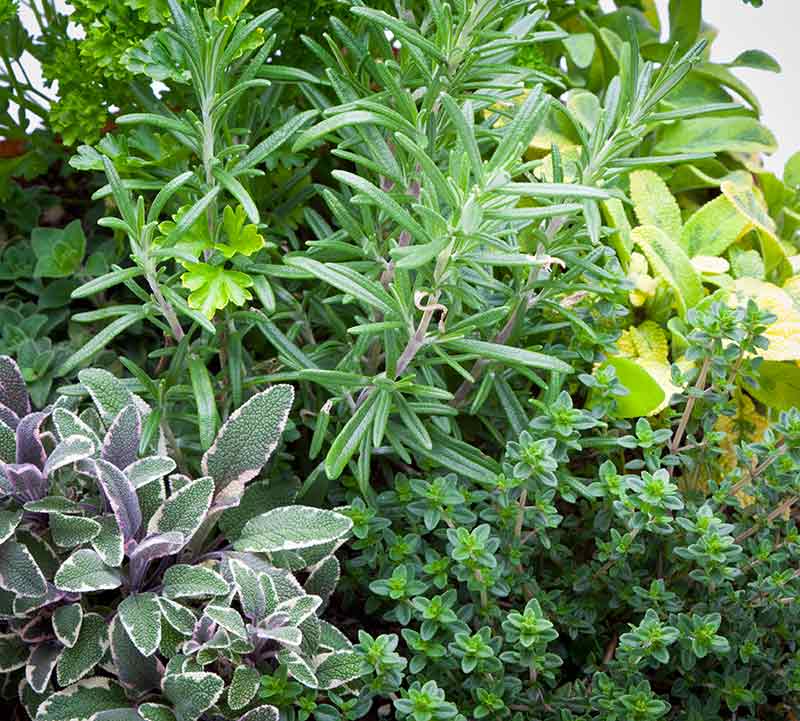How to Grow Container Herbs Both Indoors and Outside
Caring for herbs indoors or out isn't difficult. Mediterranean natives such as oregano, Italian parsley, rosemary, thyme and sage flourish with minimal attention. Because of their common origin, they have similar needs. So when you do your best to meet them, whether indoors or out, you'll be headed for herbal success.
Getting Sun and Soil Right
Imagine a gravelly, infertile, sunbaked hillside and you'll understand common herb preferences. Choose garden sites that get full, direct sun for at least six to eight hours each day — the more sun, the better. Sun concentrates aromatic oils and keeps herbs full and dense. Too much shade leaves them lanky and lacking flavor.
Indoor herbs need as much natural sunlight as your home allows. South- or southwest-facing windows are ideal. If you're short on sunlight, supplement with extra household lighting. No need for grow lights; any type of lighting works! If herbs lean toward windows, turn their pots a quarter turn every time you water to assure balanced growth.
Excellent drainage is essential, no matter how you grow herbs. Poor drainage quickly leads to root problems, including rot. Give herbs coarse, fast-draining soil, so roots get air as well as water. Herbs in containers need good drainage holes so water flows through freely.
Meeting Water and Nutrient Needs
Established garden herbs rarely need supplemental water, except during drought. Water herbs deeply and infrequently to encourage deep, healthy root growth. When soil a few inches down feels dry, water again. Basil and parsley do well with more moisture, but sturdier, water-wise herbs, such as rosemary and sage, like it slightly dry. Never leave herb soil soggy.
Water container herbs until all the soil is moist and water runs out drainage holes. Water again when the soil's top inch dries. Occasional showers in the kitchen sink are fine, but keep saucers free of excess water.
A gentle, natural fertilizer such as Alaska Fish Fertilizer 5-1-1, nourishes herbs and replaces lost nutrients. Mix this plant food with water and add into the soil to enhance the strength of your potted herbs.

Choosing Containers and Companions
Herbs suit various types of containers, from indoor hanging baskets and outdoor patio pots to narrow window trays, but containers dry out faster than in-ground gardens. Small pots dry out first, and outdoor pots exposed to winds and more direct sun dry out faster than pots protected indoors. So, water accordingly.
Pot materials influence growing conditions and how well roots breathe. Porous terra cotta pots let air and moisture pass through sides, top and bottom, but dry out faster than glazed or plastic pots and need closer monitoring and maintenance.
With their similar requirements and qualities, herbs such as rosemary, sage and thyme make complementary container companions. Vigorous mints and chives are less polite and tend to take over territory. Plant them in pots of their own, indoors and out.
Managing Diseases and Pests
Herbs typically resist most pests, but that doesn't mean they won't try to invade. Slugs and snails are pesky mollusks that love to eat newly planted, tender leaves and herbs. Visible signs can be mucus trails, holes in leaves and plants. Corry's Slug & Snail Killer can be used in fruit, vegetable and herb gardens, and immediately stops slugs and snails from feeding.

Harvesting for Extended Enjoyment
Wherever you grow herbs, harvest often so they stay full and productive. Keep them looking their best – especially when using as décor – by taking stems from throughout the plant. Cut stems right above a set of new leaves. This encourages branching and keeps herbs looking balanced and natural. For larger harvests, trim evenly all around.
Flowering slows leaf growth and causes some herbs, such as basil, to turn bitter. Trim regularly or pinch off buds to prevent blossoms, or use blooming herbs in vases instead of sautés. Herbs such as sage, oregano and rosemary start well from simple cuttings. Share your bounty, fresh and dried, by turning trimmings into new plants for family and friends.
By adding herbs to your indoor and outdoor gardening repertoire, you can enjoy the taste and aroma of healthful herbs year-round. With natural support from the Alaska and Corry's brands, you can grow herbs indoors and out with ease.
Always read the product label and follow the instructions carefully.
Corry's and Alaska are registered trademarks of Central Garden & Pet Company. Pennington is a registered trademark of Pennington Seed, Inc.
Get Monthly Gardening Advice!





